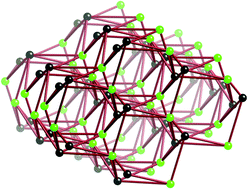Reported herein is the synthesis and structural characterisation of the novel ligand, 4,4′,6,6′-tetracarboxylic acid-2,2′-bipyridine (H4tcbp), along with an investigation of its coordination chemistry. Single crystal X-ray diffraction studies showed H4tcbp crystallises as a dihydrate and that intermolecular hydrogen bonding involving adjacent 4,4′-carboxylic acid groups form a R22(8) dimer motif whereas the 6,6′-carboxylic acid groups hydrogen bond together via the lattice water molecules [R44(12)] to form a 2D grid which is 3-fold interpenetrated and yields a 3D hydrogen bonded network. The reaction of H4tcbp under solvothermal conditions in MeOH with Ln(III) (Ln = Yb, Gd and Sm) lead to the isolation of {[Yb(Me2tcbp)2]·H2O·MeOH·H3O}, 1, and {[Ln(Me2tcbp)2]·2H2O·H3O}, where Ln = Gd, 2, or Sm, 3, and when in the presence of Yb(III) and Cu(II) to the mixed-metal species, {[Yb2(Me2tcbp)2]2Cu(OMe)2(H2O)2]·6MeOH}, 4, which were structurally characterised. Under these synthetic conditions the H4tcbp ligand di-esterified in situ at the remote 4- and 4′-carboxylic acid groups to form the 4,4′-dimethylcarboxy-6,6′-dicarboxy-2,2′-bipyridine ligand (Me2tcbp2–). Although 1 is monomeric, extensive hydrogen bonding between lattice water molecules, hydronium counterions and deprotonated carboxylate oxygen atoms results in 2D bilayer structure. Isostructural 2 and 3 are discrete mononuclear complexes whereas the tri-nuclear 4 forms a 2D sheet through face-to-face π–π interactions between adjacent units. In addition, the structural characterization and thermal analysis of four alkaline earth metal 3D coordination networks are reported, two of which feature the H4tcbp ligand: [Ba2(tcbp)(H2O)2] 5 and [CuSr(tcbp)(H2O)3] 6 (a 5,6-connected net), with the remaining two featuring the related 4,4′-dicarboxy-2,2′-bipyridine (H2dcbp) ligand: {[Ba(dcbp)(H2O)0.4]·0.6H2O} 7 (a bi-nodal 6-connected net) and {[Sr(dcbp)]·H2O} 8 (a uni-nodal 6-connected net).


 Please wait while we load your content...
Please wait while we load your content...